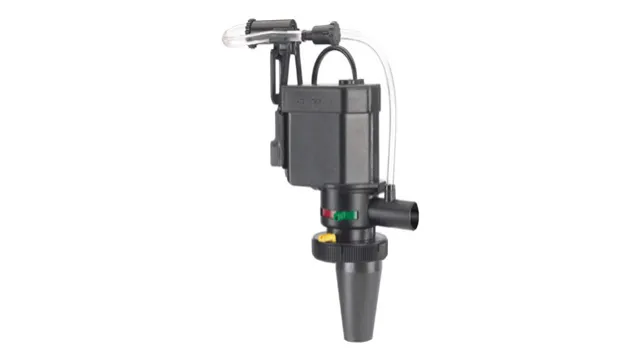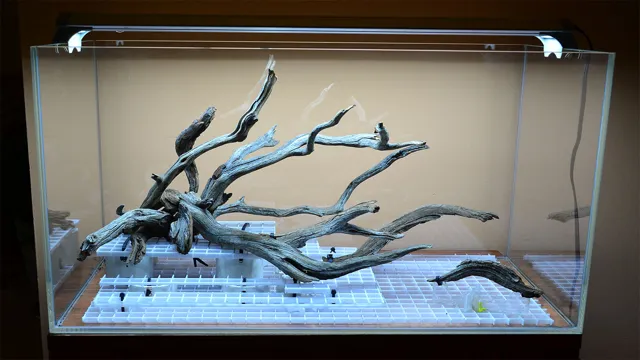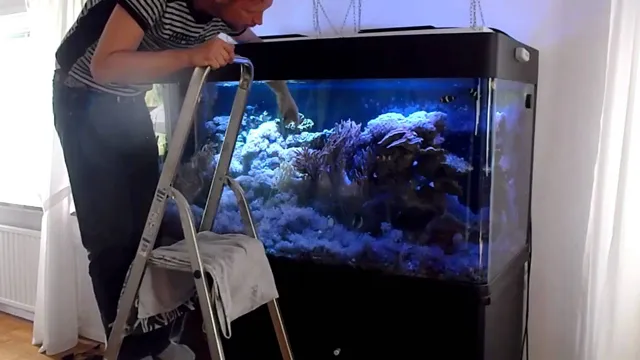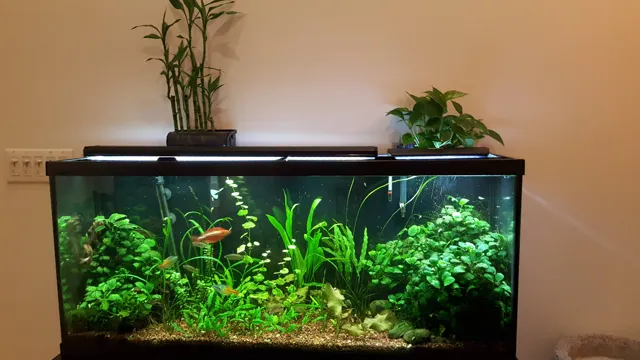Planning to set up an aquarium is a delightful experience. Building the perfect ecosystem requires attention to even the smallest of details- even the powerheads. Overlooking this essential element can lead to a suboptimal aquatic environment where your fish won’t thrive.
A powerhead aids in creating water current and movement that simulate the natural habitats of marine life in the sea. Knowing the correct size of powerheads to install is essential for maintaining healthy aquatic conditions. In this blog post, we’ll explore the factors you need to consider to appropriately size a powerhead for your aquarium.
As you read on, you’ll discover helpful tips that will ensure the best possible experience for you and your fish.
Understand Your Tank’s Water Flow Requirements
When it comes to setting up a healthy and thriving aquarium, the water flow in your tank is crucial. You want to make sure your marine life is staying active and healthy, but you also don’t want too much water flow to stress them out. This is where properly sizing a powerhead comes in.
A powerhead is a great way to increase the circulation and water flow in your aquarium, and it is essential to choose the correct size to meet your tank’s requirements. The main keyword, “how to properly size a powerhead to aquarium,” means assessing the size and volume of your aquarium and identifying the type and number of marine life you have. Measuring the volume and determining what type of fishes and corals you have in your aquarium will enable you to pick a powerhead that will provide sufficient water flow without creating too much turbulence or stress.
Make sure you do your research, so you can give your aquatic friends the perfect environment they need to thrive.
Compare Tank Volume to Powerhead Flow Rate
When it comes to creating the perfect environment for your fish, understanding flow requirements is crucial. The volume of your tank is essential in determining the optimal powerhead flow rate. Essentially, you want to ensure that the water current is strong enough to keep your fish healthy, but not too strong that it overpowers them.
It’s like a person trying to stand upright in a fierce wind; too much strength can push them over, but too little can leave them struggling to stand upright. The volume of your tank is a good starting point, as a larger tank will require a higher powerhead flow rate, while smaller tanks will need a gentler flow. By understanding the specific flow requirements of your tank, you can ensure that your fish thrive in their aquatic environment.

Consider Aquatic Life Needs
When it comes to setting up an aquatic environment in your home, understanding your tank’s water flow requirements is crucial to maintain a healthy and thriving ecosystem. Every aquatic creature has its specific needs, and the flow of water in your tank plays a vital role in providing them with the ideal living conditions. Whether it’s freshwater or saltwater species, the water flow affects the oxygenation, nutrient distribution, and waste removal in the tank.
For instance, some fish species, such as angelfish or gourami, prefer calm waters, while others, like tetras or danios, require a moderate flow to thrive. Similarly, corals and invertebrates need a steady, gentle flow to obtain their nutritional needs and remove waste efficiently. Therefore, it is crucial to research the water flow requirements for your aquatic pets and ensure your tank’s filtration system provides adequate flow rates to meet their needs.
Paying attention to their water flow requirements will help you maintain a healthy and happy aquatic ecosystem.
Determine Placement of Powerhead
When it comes to setting up an aquarium, the placement of the powerhead can be critical. Powerheads can come in different sizes and flow rates, and it’s essential to properly size them for your aquarium’s needs. Too much flow can cause stress for some aquatic creatures, while too little flow can lead to dead spots where debris and waste can accumulate. (See Also: How to Clean Aquarium Sump Tank: A Step-by-Step Guide to a Pristine Tank)
Start by measuring the volume of your tank to determine the appropriate flow rate for your powerhead. A good rule of thumb is to aim for a turnover rate of 10-15 times per hour. So, for example, for a 50-gallon tank, you’ll want a powerhead that can provide a flow rate of 500-750 gallons per hour.
Once you’ve determined the appropriate flow rate, consider the placement of the powerhead. It’s best to position it near the bottom of the tank, angled upwards at a 45-degree angle towards the surface. This helps to promote adequate circulation and oxygenation throughout the tank, while also creating gentle currents instead of strong directional flow.
Remember to adjust the angle or position of your powerhead if you notice any areas with stagnant water or debris buildup. With the right placement and sizing, your powerhead can help provide a healthy aquatic environment for your fish and plants.
Create Circulation Patterns
When setting up a saltwater aquarium, creating circulation patterns is crucial. To do so, it’s important to determine the placement of powerheads. Powerheads are devices that help move water around the tank and prevent dead spots, which can be harmful to fish and corals.
The placement of powerheads depends on the size and shape of your tank, as well as the types of aquatic life you plan on keeping. In general, it’s a good idea to point powerheads at each other to create a circular flow of water. This helps to evenly distribute nutrients and oxygen throughout the tank, creating a healthier environment for your fish and corals.
Additionally, it’s important to avoid pointing powerheads directly at any delicate creatures, as this can cause damage or stress. Take the time to carefully plan and adjust the placement of your powerheads to ensure optimal circulation in your saltwater aquarium.
Avoid Directing Flow Too Strongly
When it comes to setting up your aquarium, it’s important to keep in mind the placement of your powerhead. While you want to ensure sufficient water circulation throughout your tank, you don’t want to create a current that’s too strong for your fish to handle. One way to determine the best placement for your powerhead is to consider the layout of your tank and how water might flow naturally in that space.
You may also want to experiment with different locations and angles to find the optimal position. By avoiding directing flow too strongly, you can keep your fish safe and happy while still maintaining a healthy and vibrant aquatic environment.
Be Mindful of Obstacles
When setting up your aquarium, it’s important to be mindful of any obstacles that could hinder the flow of water. One key factor to consider is the placement of the powerhead. A powerhead is a device that helps circulate water in your aquarium, providing oxygen to your fish and removing debris.
However, if it’s placed in the wrong location, it can create turbulent flow that can harm delicate corals and other aquatic life. Make sure to position the powerhead in a way that makes sense for your specific tank setup, taking into account the size and location of any rocks or decorations. By keeping these obstacles in mind and carefully considering the placement of your powerhead, you can ensure healthy and happy aquatic life in your aquarium.
Calculate Powerhead Quantity
One of the key factors in maintaining a healthy and thriving aquarium is choosing the right powerhead. To properly size a powerhead to your aquarium, there are a few things you need to consider. First and foremost, the tank’s size will determine the quantity of powerheads needed. (See Also: How to Convert a TV to an Aquarium: A Step-by-Step Guide)
Generally, it is recommended to have a powerhead that circulates the water at least 10 times per hour, though this can vary depending on the specific needs of your aquarium. The powerhead’s flow rate and outlet size are also important factors to consider. It is essential to ensure that the powerhead’s flow rate, measured in gallons per hour, matches the needs of your aquarium’s inhabitants.
Additionally, the outlet size of the powerhead must be adequate to avoid any backpressure or strain on the unit. By taking these factors into account, you can calculate the proper number and size of powerheads needed for your aquarium, keeping your aquatic friends happy and healthy.
Ratio of Tank Volume to Powerhead Flow Rate
When setting up an aquarium, it’s important to ensure the right balance between the tank volume and powerhead flow rate. But how do you calculate the necessary powerhead quantity for a given tank volume? Well, it depends on a few factors, such as the type of fish you plan to keep and the amount of filtration required. As a general rule of thumb, you should aim for a flow rate of around 5-10 times the tank volume per hour.
So, for a 50-gallon tank, you would need a powerhead with a flow rate of 250-500 gallons per hour. Keep in mind that too much or too little flow can have negative effects on your fish and plants. Too much flow can stress out some fish and make it harder for them to swim, while too little flow can result in stagnant water and poor filtration.
Finding the right balance is key to a healthy, thriving aquarium.
Add More Powerheads for Larger or Complex Tanks
If you have a larger or more complex fish tank, adding more powerheads can greatly benefit the overall health of your aquatic environment. But how do you determine the appropriate quantity of powerheads needed? Firstly, consider the volume of your tank and the flow rate required for your desired species of fish and coral. A general rule of thumb is to have a turnover rate of 10-20 times the volume of your tank per hour.
So, if you have a 100-gallon tank, you will need a powerhead that can circulate water at a rate of 1000-2000 gallons per hour. Additionally, assess the layout of your aquarium and any obstacle that may hinder water flow. The goal is to ensure that all areas of your tank receive optimal water circulation, including the corners and areas furthest from your filtration system.
By determining the appropriate quantity of powerheads for your tank, you can create a healthy and vibrant aquatic environment for your beloved marine life to thrive.
Final Thoughts
So, that’s the gist of how to properly size a powerhead to your aquarium. As we’ve discussed, it’s essential to consider the size and shape of your tank, the type and size of your fish, as well as the flow rate and flow pattern of the powerhead in question. A powerhead that’s too strong or too weak can create a variety of problems for your aquatic pets, from too much stress to stagnant areas where waste can accumulate.
By taking the time to properly size and position your powerhead, you’ll be ensuring healthy, thriving fish and a beautiful, balanced aquarium ecosystem. Remember to use the main keyword ‘how to properly size a powerhead to aquarium’ strategically throughout your blog post, so that you can get the organic traffic and engagement your content deserves.
Conclusion
In summary, selecting the right powerhead for your aquarium is crucial for maintaining a healthy and thriving aquatic environment. It’s important to consider factors such as the size and type of your tank, the flow rate and direction, and the needs of your fish and coral. Remember, the powerhead is the beating heart of your aquarium’s circulation system, so choosing the perfect fit will keep everything flowing smoothly and your aquarium looking its best. (See Also: How to Make a Spray Bar for Aquarium: A Step-by-Step Guide for Efficient Water Circulation)
So don’t be a fish out of water, take the time to properly size your powerhead and watch your underwater world flourish!”
FAQs
What factors should be considered when choosing a powerhead for an aquarium?
When selecting a powerhead, you should consider the size of your aquarium, the flow rate required by your particular species, and the desired flow pattern.
Can a powerhead be too powerful for an aquarium?
Yes, a powerhead that is too powerful can create too much water movement, causing stress or harm to the fish and other inhabitants of the tank.
How do I determine the correct flow rate for a powerhead in my aquarium?
The recommended flow rate for a powerhead is typically between 5 and 10 times the volume of the aquarium per hour. For example, a 50-gallon tank should have a powerhead with a flow rate of 250 to 500 gallons per hour.
Is it necessary to have more than one powerhead in an aquarium?
Depending on the size and shape of your aquarium, it may be necessary to have multiple powerheads to ensure proper water flow and oxygenation.
Can a powerhead be used in a freshwater aquarium?
Yes, powerheads are commonly used in freshwater aquariums to provide water movement, assist with filtration, and create a more natural environment for the aquatic inhabitants.
How often should a powerhead be cleaned in an aquarium?
Powerheads should be cleaned every 2-3 months to prevent blockages and maintain optimal performance.
Can a powerhead be used with a canister filter in an aquarium?
Yes, a powerhead can be used in conjunction with a canister filter to enhance water flow and filtration.







